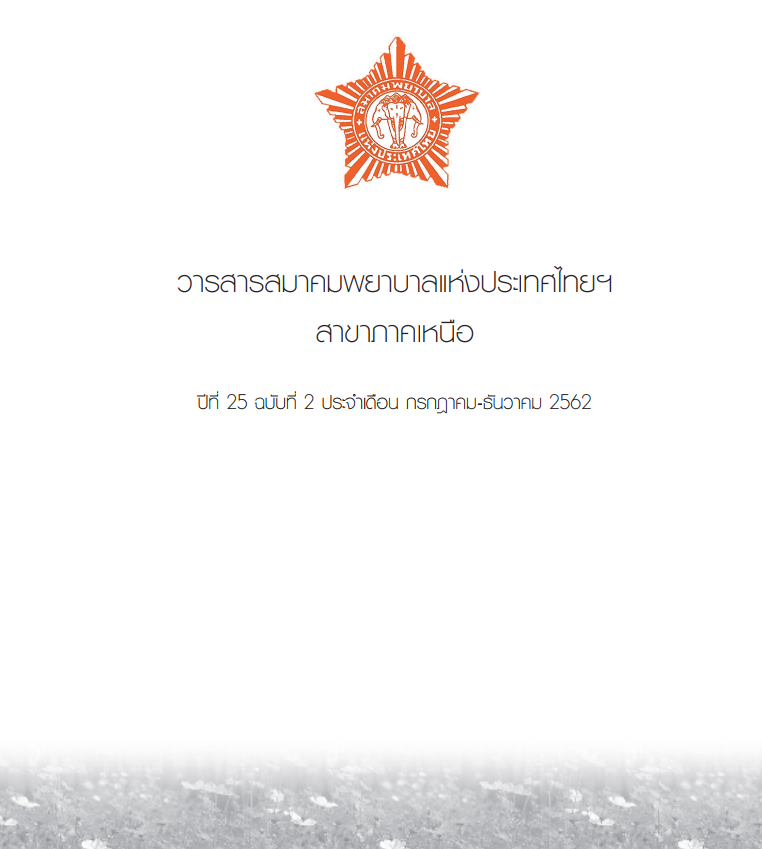Disaster Preparedness for Children: Nurses’ Roles
Keywords:
Nurses' roles, Disaster preparedness, ChildrenAbstract
Disaster has a direct impact on health, causing loss in many dimensions, and with a high tendency to occur in the future. Disaster preparedness is necessary to reduce its severity of impacts. Particularly, children who are considered as a vulnerable group affected by the disaster. Disaster preparedness enhances children to encounter the disaster safely. It also changes their status from the ones who are waiting for helps, to the ones who can take care of themselves and help others. Thus, the policy of supporting the disaster preparedness for children was set from international level to practical level. Disaster preparedness includes the following components; knowledge resources or experts, contents preparations, methods preparations, and disaster management. The local agencies should be integrated in order to educate and train children. Nurses in communities, play important roles in preparing children to handle the disaster by raising awareness, educating children’ carers and community, supporting and encouraging disaster drills, monitoring their knowledge, and developing guidelines for disaster preparedness for children. It is aimed to achieve safety, reduce loss, having a good health and quality of life. Finally, suggestions for improving nurses’ capacity development in disaster preparedness for children are as follows: gaining an understanding of disaster concepts, disaster management, expertise in emergency, and communications.
References
กรมป้องกันและบรรเทาสาธารณภัย. การลดความเสี่ยงจากภัยพิบัติสู่การพัฒนาที่ยั่งยืน. กรุงเทพฯ; สำนักงานโครงการแห่งสหประชาชาติ; 2557.
กรมป้องกันและบรรเทาสาธารณภัย. การลดความเสี่ยงจากสาธารณภัย. กรุงเทพฯ; โรงพิมพ์ชุมนุม เกษตรกรแห่งประเทศไทย; 2556.
Workpointnews. สรุปตัวเลขเหตุการณ์น้ำท่วม 62 วันที่ 18 กันยายน 2562. 2562.[เข้าถึงเมื่อ /2562/10/27]. เข้าถึงได้จาก: workpointnews.com/2019/09/18 /floods-saveubon-numbers- 17sep.
The united nations. Sustainable development goals. 2015. [เข้าถึงเมื่อ /2561/12/13]. เข้าถึงได้จาก: www.un.org/sustainabledevelopment/ sustainable-development-goals.
Baytiyeh,H. Are colleage inLebanon preparing students for future earthquake disaster. International journal of disaster risk reduction. 2015;14: 919-926.
มูลนิธิศูนย์เตรียมความพร้อมภัยพิบัติแห่งเอเชีย.การประเมิน แผน นโยบายและการดำเนินงานจัดการ ภัยพิบัติในประเทศไทย. กรุงเทพฯ;เฮลเอจอินเตอร์เนชั่นแนล; 2556.
Siam intelligence. Practical report ประเมินความเสียหายจากวิกฤตนำท่วมของ 6 ประเทศใน อาเซียน.2559[เข้าถึงเมื่อ /2561/9/5]. เข้าถึงได้จาก: www.siamintelligence.com/flood-crisison- 6-member-states-in-asean.
ผู้จัดการออนไลน์. อีก 10 ปี เด็ก 175 ล้านคน รับผลกระทบภัยพิบัติ จับมือ สพฐ.ทำคู่มือสอนใน ร.ร. 2559. [เข้าถึงเมื่อ /2561/9/5]. เข้าถึงได้จาก:co.th/qol/viewnews.aspx?NewsID =9590000115566.
UNICEF. Flood situation in the northeastern of Thailand 2019. 2019[เข้าถึงเมื่อ /2562/11/23]. เข้าถึงได้จาก: https://www.unicef.org/thailand/flood-situation- northeast ern-thailand-2019.
Elangovan,R.A.& Kasi,S. Psychosocial disaster preparedness for school children by teachers. International journal of disaster risk reduction. 2015; 12: 119-124.
ศรีเวียง ไพโรจน์กุล.คู่มือสำหรับกุมารแพทย์เพื่อเผยแพร่ความรู้ในการดูแลเด็กและครอบครัว ตอนการช่วยเหลือเด็กในภาวะภัยพิบัติ. กรุงเทพฯ: ราชวิทยาลัยการแพทย์แห่งประเทศไทยและสมาคม กุมารแพทย์แห่งประเทศไทย; 2554.
ดวงรมณ ภาพย์ตันติ. เด็กคิดอย่างไรเรื่องการลดความเสี่ยงจากภัยพิบัติและการฟื้นตัวสู่สภาวะปกติ ในเขตชุมชนเมือง. กรุงเทพฯ: องค์กรช่วยเหลือเด็ก; 2559.
กรมป้องกันและบรรเทาสาธารณภัย. การลดความเสี่ยงจากสาธารณภัย. กรุงเทพฯ: โรงพิมพ์ชุมนุม เกษตรกรแห่งประเทศไทย; 2559.
UNISDR. Disaster preparedness for effective response. Geneva; Switzerland. 2007. [เข้าถึงเมื่อ/2561/12/13]. เข้าถึงได้จาก: www.unisdr.org/we/inform/ publications/1130.
Baytiyeh,H. Are colleage inLebanon preparing students for future earthquake disaster. International journal of disaster risk reduction. 2015;14: 919-926.
ทับทิม ปัตตะพงศ์, บำเพ็ญจิต แสงชาติ, พูลสุข ศิริพูล. การรับรู้การเตรียมพร้อมรับภัยพิบัติในเด็ก วัยเรียนที่อยู่ในพื้นที่เสี่ยงภัย. วารสารพยาบาลศาสตร์และสุขภาพ. 2562; 42(1):43-51.
UNISDR. Words into action; implement guide for the sendai framework. 2015. [เข้าถึง เมื่อ 2562/6/15]. เข้าถึงได้จาก: www.preventionweb.net/drr-framework/sendai-framework/ wordsintoaction.
ASEAN. AADMER work program 2016-2020. Indonesia: Jakata; 2016.
สำนักงานคณะกรรมการพัฒนาเศรษฐกิจและสังคมแห่งชาติ.แผนพัฒนาเศรษฐกิจและสังคมแห่งชาติ ฉบับที่ 12. 2559. [เข้าถึงเมื่อ/2561/12/13]. เข้าถึงได้จาก: www.ratchakitcha.soc.go.th/data/ pdf/2559/A/115/1.pdf.
คณะกรรมการป้องกันและบรรเทาสาธารณภัยแห่งชาติ.แผนป้องกันและบรรเทาสาธารณภัยแห่งชาติ พ.ศ. 2558. กรุงเทพฯ: กรมป้องกันและบรรเทาสาธารณภัย กระทรวงมหาดไทย ; 2558.
Sharpe, J. & Izadkhah,O.Y., Use of comic strips in teaching earthquakes to kindergarten children. Disaster prevention and management. 2014; 23(2);138-156.
Gulay,H. An earthquake education program with parent participation for preschool children. Education research and review. 2010; 5(10):624-630.
Nouchi,R. & Sugiura,M. Beneficial effect of learning with game book on education for disaster prevention in children. Journal of disaster research. 2014; 9(6);1079-1087.
Ronan, R.K. Community readiness for a new tsunami warning system: quasi experimental and benchmarking evaluation of school education component. Natural Hards. 2012; 61; 1411-1425.
Johnson, A.V, Ronan, R.K, Johnston, M.D, and Peace, R. Improving the impact and implementation of disaster education; programs for children through theory based evaluation. Risk analysis. 2016; 36(11): 2120-2135.
Shaw, R, Takeuchi, Y, Ru Gwee, Q, Shiwaku, K. Disaster education: an introduction. Community, Environment and Disaster Risk Management. 2011; 7: 1-22.
Jakeway,C.C, Larosa, G, Cary, A, Schoenfisch, S. The role of public health nurses in emergenct preparedness and response: a position paper of the association of state and territorial directors of nursing. Public health nursing. 2008; 25(4): 353-361.
World Health Organization & International Council of Nurse. ICN framework of disaster competency nursing. Switzerland: Geneva; 2009.
Downloads
Published
How to Cite
Issue
Section
License
บทความที่ได้รับการตีพิมพ์เป็นลิขสิทธิ์ของสมาคมพยาบาลแห่งประเทศไทยฯ สาขาภาคเหนือ
เนื้อหาและข้อคิดเห็นใดๆ ที่ตีพิมพ์ในวารสารสมาคมพยาบาลฯ ถือเป็นความรับผิดชอบของผู้เขียนเท่านั้น ผู้เขียนบทความต้องศึกษารายละเอียดหลักเกณฑ์การจัดทำต้นฉบับตามที่วารสารกำหนด และเนื้อหาส่วนภาษาอังกฤษต้องได้รับการตรวจสอบจากเจ้าของภาษามาแล้ว


